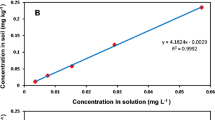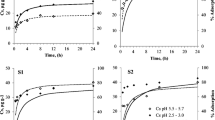Abstract
Agrochemical-based soil and water contamination has been posing serious threats to ecological balance. Current research investigates the sorption and mobility behaviour of a Benzylurea insecticide, Chlorfluazuron (CFZ), by a standard batch equilibrium method. After investigation of soils’ physical and chemical properties, sorption assays have been performed on five soils from agriculturally significant regions where CFZ can probably occur. CFZ expressed poor adsorption on the selected soils with linear adsorption coefficient, i.e. Kd(ads), ranging between 6.08 and 9.57 µg/mL and Freundlich adsorption coefficient Kf(ads) having a range of 4.18–9.01 µg/mL. Linear and Freundlich models displayed correlation coefficient R2 value to be >0.84 and 0.83, respectively, reflecting the goodness of fit of the experimental data. Furthermore, the mobility of CFZ was assessed using the McCall classification based on Koc values. CFZ expressed high mobility in soils with less adsorption. The adsorptive and desorptive interactions were highly dependent upon soil physicochemical characteristics. Based on the current investigation, CFZ can be predicted to be a potential threat for soils with a low adsorptive affinity towards it. Future investigations in this regard can consider the use of sustainable materials and procedure for CFZ decontamination in vulnerable soils.







Similar content being viewed by others
References
Evans T A and Iqbal N 2015 Termite (order Blattodea, infraorder Isoptera) baiting 20 years after commercial release. Pest Manag. Sci. 71(7): 897–906
Carbo L, Martins E L, Dores E F, Spadotto C A, Weber O L and De-Lamonica-Freire E M 2007 Acetamiprid, carbendazim, diuron and thiamethoxam sorption in two Brazilian tropical soils. J. Environ. Sci. Health Part B 42(5): 499–507
Zhang W, Jiang F and Ou J 2011 Global pesticide consumption and pollution: with China as a focus. Proc. Int. Acad. Ecol. Environ. Sci. 1(2): 125
Mostafalou S and Abdollahi M 2013 Pesticides and human chronic diseases: evidences, mechanisms, and perspectives. Toxicol. Appl. Pharmacol. 268(2): 157–177
UNEP 2004 Stockholm convention on persistent organic pollutants. United Nation Environment Programme, available from http://chm.pops.int/TheConvention/ThePOPs/ListingofPOPs (accessed July 2017)
Unsworth J 2010 History of pesticide use. International Union of Pure and Applied Chemistry (IUPAC), available from http://agrochemicals.iupac.org/index.php?optioncom_sobi2Details&catid-3&sobi2Id-31 (accessed July 2017)
Ghimire N and Woodward R T 2013 Under- and over-use of pesticides: an international analysis. Ecol. Econ. 89: 73–81
Farzana P 2012 Chlorfluazuron as reproductive inhibitor. In: Farzana P (Ed.) Insecticides—Pest Engineering. Rijeka, Croatia: InTech, pp. 23–62. ISBN 978-953-307-895-3
Huo J C, Sun Y, Xu Y M, Qin X, Dai X H and Wei D 2010 Residue detection and degradation of chlorfluazuron in rice, soil and field water. J. Saf. Environ. 6: 004
Chakraborty A and Sun B 2014 An adsorption isotherm equation for multi-types adsorption with thermodynamic correctness. Appl. Therm. Eng. 72(2): 190–199
Ganguly P, Barik S R, Patra S, Roy S and Bhattacharyya A 2017 Persistence of chlorfluazuron in cabbage under different agro-climatic conditions of India and its risk assessment. Environ. Toxicol. Chem. https://doi.org/10.1002/etc.3872
Radolinski J, Wu J, Xia K and Stewart R 2018 Transport of a neonicotinoid pesticide, thiamethoxam, from artificial seed coatings. Sci. Total Environ. 618: 561–568
Leyva-Ramos R 2010 Fundamentos de adsorción en sistemas liquido-sólido. Situacion del arsenico en la Region Iberica e Iberoamericana. Posibles acciones articuladas e integradas para el abatimiento del arsenico en zonas aisladas. Argentina: CYTED, p. 43
Chefetz B, Mualem T and Ben-Ari J 2008 Sorption and mobility of pharmaceutical compounds in soil irrigated with reclaimed wastewater. Chemosphere 73: 1335–1343
Rodríguez-Liébana J A, Mingorance M D and Peña A 2013 Pesticide sorption on two contrasting mining soils by addition of organic wastes: effect of organic matter composition and soil solution properties. Colloids Surf. A Physicochem. Eng. Asp. 435: 71–77
[16] Rodríguez-Liébana J A, Mingorance M D and Peña A 2011 Sorption of hydrophobic pesticides on a Mediterranean soil affected by wastewater, dissolved organic matter and salts. J. Environ. Manag. 92: 650–654
ElGouzi S, Mingorance M D, Draoui K, Chtoun E H and Peña A 2012 Assessment of phenylurea herbicides sorption on various Mediterranean soils affected by irrigation with wastewater. Chemosphere 89: 334–339
Borgman O and Chefetz B 2013 Combined effects of biosolids application and irrigation with reclaimed wastewater on transport of pharmaceutical compounds in arable soils. Water Res. 47: 3431–3443
No O T 2000 Adsorption–desorption using a batch equilibrium method. OECD Guidelines for the Testing of Chemicals 106, pp. 1–45
Alfonso L F, Germán G V, del Carmen P C M and Hossein G 2017 Adsorption of organophosphorus pesticides in tropical soils: the case of karst landscape of northwestern Yucatan. Chemosphere 166: 292–299
Ahmad K S, Rashid N and Zakaria M 2015 Adsorption and desorption characteristic of metsulfuron-methyl in Pakistani soils. J. Chem. Soc. Pak. 37(2): 380–389
Ahmad K S, Rashid N, Nazar M F and Tazaiyen S 2013 Adsorption and desorption characteristic of benzimidazole based fungicide carbendazim in Pakistani soils. J. Chem. Soc. Pak. 34(3): 1017–1024
Ahmad K S, Rashid N, Tazaiyen S and Zakria M 2014 Sorption–desorption characteristics of benzimidazole based fungicide 2-(4-fluorophenyl)-1h-benzimidazole on physicochemical properties of selected Pakistani soils. J. Chem. Soc. Pak. 36: 1189–1195
Khalid R, Mahmood T, Bibi R, Siddique M T, Alvi S and Naz S Y 2012 Distribution and indexation of plant available nutrients of rainfed calcareous soils of Pakistan. Soil Environ. 31(2): 146–151
Latif R, Ali S and Hayat R 2008 Nitrogen fixation and yield of peanut affected by inorganic fertilizers, variety and inoculums interaction in rainfed areas of Punjab. Soil Environ. 27: 77–83
Nemeth-Konda L, Füleky G, Morovjan G and Csokan P 2002 Sorption behaviour of acetochlor, atrazine, carbendazim, diazinon, imidacloprid and isoproturon on Hungarian agricultural soil. Chemosphere 48(5): 545–552
Banerjee K, Patil S H, Dasgupta S, Oulkar D P and Adsule P G 2008 Sorption of thiamethoxam in three Indian soils. J. Environ. Sci. Health B 43(2): 151–156
Kandil M M, El-Aswad A F and Koskinen W C 2015 Sorption–desorption of imidacloprid onto a lacustrine Egyptian soil and its clay and humic acid fractions. J. Environ. Sci. Health B 50(7): 473–483. https://doi.org/10.1080/03601234.2015.1018758
El Arfaoui A, Sayen S, Paris M, Keziou A, Couderchet M and Guillon E 2012 Is organic matter alone sufficient to predict isoproturon sorption in calcareous soils? Sci. Total Environ. 432: 251–256
Kah M, Beulke S and Brown C D 2007 Factors influencing degradation of pesticides in soil. J. Agric. Food Chem. 55(11): 4487–4492. https://doi.org/10.1021/jf0635356
Dankyi E, Gordon C, Carboo D, Apalangya V A and Fomsgaard I S 2018 Sorption and degradation of neonicotinoid insecticides in tropical soils. J. Environ. Sci. Health B 53(9): 587–594
Ahmad K S 2017 Determination of Rimsulfuron sorption parameters in eight Pakistani soils. Agrochimica 61(2): 140–153
Ahmad K S 2017 Investigating the impact of soils physiochemical composition on chlorsulfuron pedospheric sorption. Studia Universitatis Babes-Bolyai Chemia 62(1): 165–174
Ahmad K S 2017 Pedospheric sorption investigation of sulfonyl urea herbicide Triasulfuron via regression correlation analysis in selected soils. S. Afr. J. Chem. 70(1): 163–170
Ahmad K S 2017 Green electrokinetic remediation of Thiabendazole adsorbed soils via mineralization. Agrochimica 61(3): 190–205
Ahmad K S 2018 Evaluating the adsorption potential of alachlor and its subsequent removal from soils via activated carbon. Soil Sediment Contam. Int. J. 28: 249–266
Rodríguez-Liébana J A, Mingorance M D and Peña A 2018 Thiacloprid adsorption and leaching in soil: effect of the composition of irrigation solutions. Sci. Total Environ. 610: 367–376
Friedel J K, Langer T, Siebe C and Stahr K 2000 Effects of long-term waste water irrigation on soil organic matter, soil microbial biomass and its activities in central Mexico. Biol. Fertil. Soils 31: 414–421
Fernández-Gálvez J, Gálvez A, Peña A and Mingorance M D 2012 Soil hydrophysical properties resulting from the interaction between organic amendments and water quality in soils from Southeastern Spain: a laboratory experiment. Agric. Water Manag. 104: 104–112
Lado M, Bar-Tal A, Azenkot A, Assouline S, Ravina I, Erner Y, Fine P, Dasberg S and Ben-Hur M 2012 Changes in chemical properties of semiarid soils under long-term secondary treated wastewater irrigation. Soil Sci. Soc. Am. J. 76: 1358–1369
Assouline S, Narkis K, Gherabli R and Sposito G 2016 Combined effect of sodicity and organic matter on soil properties under long-term irrigation with treated wastewater. Vadose Zone J. https://doi.org/10.2136/vzj2015.12.0158
Singh N and Singh S B 2015 Adsorption and leaching behaviour of bispyribac-sodium in soils. Bull. Environ. Contam. Toxicol. 94(1): 125–128
Acknowledgements
The authors acknowledge Fatimah Jinnah Women University, Rawalpindi, and Higher Education Commission of Pakistan for financial support.
Author information
Authors and Affiliations
Corresponding author
Rights and permissions
About this article
Cite this article
Azhar, S., Ahmad, K.S. Pedospheric adsorption–desorption of anti-moulting agent Chlorfluazuron and transfer in agriculturally significant Arcadian soils. Sādhanā 44, 212 (2019). https://doi.org/10.1007/s12046-019-1202-1
Received:
Revised:
Accepted:
Published:
DOI: https://doi.org/10.1007/s12046-019-1202-1




